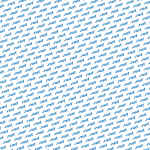
Most manufacturers offer wings in sizes between 2.5 and seven square metres. Anyone thinking about buying material for the first time is then faced with many questions: "Do I need a large 6 square metre wing or is the difference to a 5 square metre wing not that big? What gradation makes sense if I want to buy two wing sizes - a 6 and a 5? Or would I prefer a 6sqm and a small 4 wing for a lot of wind? And which brand should it be in the end?"
What our test experience has shown: The differences between the individual brands are quite striking. That's why we regularly test the latest models and tell you which wings make sense and which don't. With regard to the right wing size and the perfect gradation of wings, we asked a few wingsurfers from all over the country about their experiences. We deliberately chose wingsurfers who are not fully sponsored pros jetting around the world with a full range of different wings, but experienced hobby wingers.
"Wingsurfing is the perfect sport for gusty inland waters"
Michael Ferchert and Sebastian Potyka are keen wingsurfers at home north of the Ruhr area and have already had equipment from many manufacturers in their hands. Michael: "Here on the inland lakes, the wing is often gusty. I mainly wing at the Auesee near Wesel. At 90 kilos, I would personally always choose a board with around 120 litres and a powerful 5-wing for the start if I had to choose a wing size - that covers most of the wind conditions here. Personally, it's always important to me that the wing has a window."

"A sensible solution with two sizes would look like this for me: A size 6 wing for light winds always makes sense, you can clearly see the difference to a size 5. As a small addition, I would then choose a wing that has good control at the top, in the 5sqm size - I personally use Duotone wings in 6 and 5sqm, for example. If you are looking for wings with more power, I would choose a combination of 6 and 4.5 square metres. The lighter riders in our RTG-Wesel club often end up with a 5-square metre wing in a one-wing solution, and then with a combination of 5 and 4 square metres in a two-size solution."

For Sebastian Potyka, who has been travelling with the Wing for almost three years, the 5 is THE all-round size for beginners: "Even with my 90 kilos, a 5 Wing would always be my first choice. With a 2-wing solution, it would be the 5sqm and 4sqm sizes. I often notice that newcomers buy very large boards at the beginning. This is of course helpful for the first few sessions, but the board then quickly becomes too big. My tip: rent a big one first, then buy a smaller one!"
Flying along without whitecaps, that's what I love.
Steffi Wahl lives within walking distance of the Baltic Sea beach in California and is also fascinated by foiling. As one of the best windsurfers in Germany, she naturally had the best prerequisites and a correspondingly steep learning curve, but foiling was still uncharted territory for her when she first started wingsurfing in August 2020.
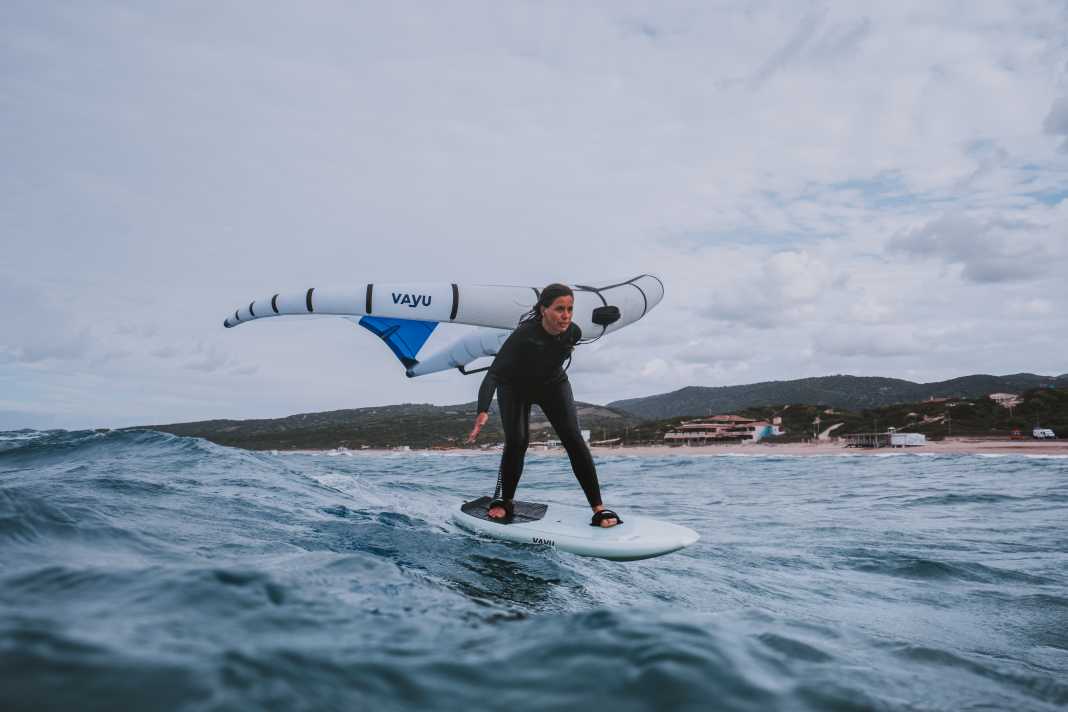


"My favourite place to wing is at the lower wind limit at 10-15 knots. I find it simply sensational that you can fly with the wing and hardly see any whitecaps. In the beginning, a wing size between 4.4 and 5 square metres was completely sufficient for my needs. With a two-wing solution, my gradation was 4.4 and 5.4 or 4.0 and 5.0 - depending on the manufacturer. I also used a 70 litre wingsurf board. As we also spend a lot of time on the water in winter and all the neoprene has its weight, I didn't want such a super small board. For me it was my body weight (63 kilos), plus a little buffer. As I like to go out in light winds, I didn't want to make it too heavy and still be able to bob around on it," says Steffi, explaining her choice of equipment. In the meantime, I've even reduced the amount of equipment I use. I'm currently using a 4.0 Vayu Aura II Wing. I now use slightly smaller versions of the board and foil - a 55-litre board and a foil with a surface area of 950 cm2."
Dominik Röckl also travels a lot on the Baltic Sea and loves wings in the waves: "I go winging in the wind range from ten to 25 knots. I weigh 73 kilos, and in the beginning a 5-weight wing was the all-round size for me too, with which I could cover the largest range. For windy days, a 4.2 was my first choice as a supplement. I now only have one wing - a 4.5. I cover all wind ranges with it. Over the years, I've gone down a bit in terms of foil area and now use a 1290 foil from Liftfoils."
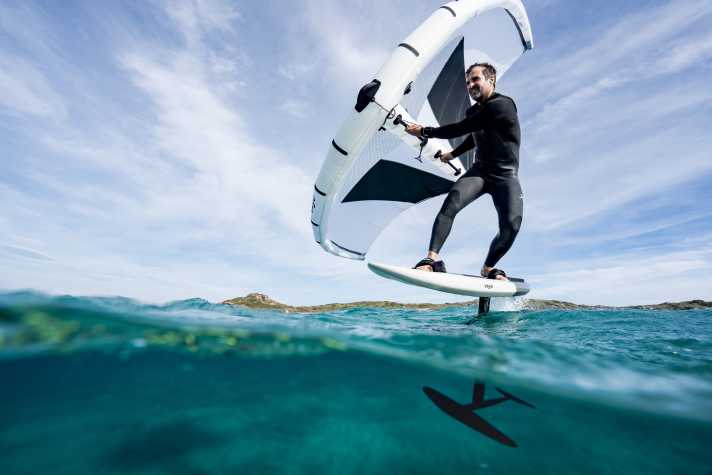
Two wings are enough for almost all windy days!
Philipp Kümpel makes the lakes in eastern Germany unsafe with his wing. His home spot is Lake Cospuden near Leipzig, where the wind is usually moderate at eight to 15 knots.
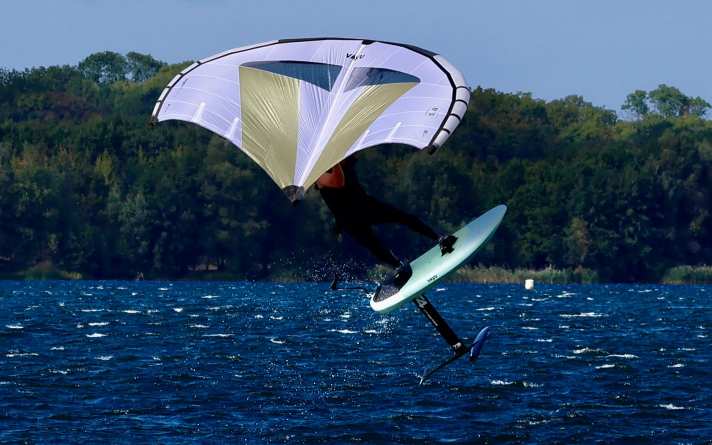
"Weighing 90 kilos, my single-wing solution at the start of my wing career was around 6.4 square metres. With good pumping technique and an 1800 foil, I was able to start flying at just under eight knots. In my opinion, a maximum of two sizes are enough at the beginning to cover almost all wind conditions - in my case these were the sizes 6.4 and 4.2 square metres. For days with strong winds, I bought a 1200 in addition to the large 1800 front wing. In the meantime, I've realised that you can ride wings that are almost a square metre smaller than at the beginning as your riding ability increases."
The lakes in the Allgäu are Daniel Schenk's home spot, who also had a wing in his hands for the first time in spring 2020. The main challenge at the mountain lakes is that frontal weather often ensures changeable wind conditions:
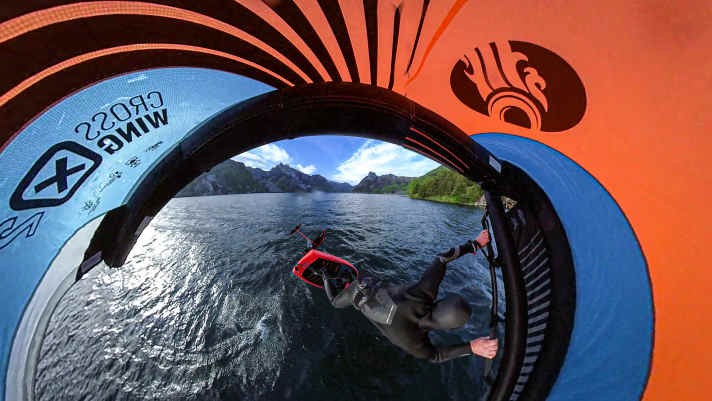
"I'm wingsurfing here in winds between eight and 40 knots, the cold fronts are sometimes really tough. The great thing about wingsurfing is that you can easily fly through the wind holes once you're up there. With a 10-12 knot gust, I can start flying (5 wing and 1300 front wing). Once up, it can also go down to 6-8 knots. Sometimes it seems to me that there is no wind at all. With my 77 kilos, the 5sqm wing size would also be the all-round solution; if I were to use two wings, I would choose 5s and 4s."
